Edition 7/November 2024 IN MEMORIAM: DAVID SIEFF, A CHERISHED COLLEAGUE AND MENTOR We are deeply saddened to share the passing of our loyal Branch supporter and the person who tirelessly kept us all informed through his work on the Golden Mortar publication, David Sieff. Our sincerest condolences go out to his family as we all feel the weight of this profound loss. David was one of our most special colleagues, a true character, and, as we often said, a real mensch. He was much loved by the PSSA Southern Gauteng Branch, to which he contributed so much and was regarded by many as a father figure. David’s dedication to the Golden Mortar was unwavering, and he remained a tireless, committed editor for many years. We could always rely on him as a solid, trusted, and fair sounding board on all things pharmaceutical. David’s selfless contributions were recognized with the prestigious and seldom-awarded Julius Israelson Award for his exceptional service to Community Pharmacy, and he was honoured as a senior Fellow of the Pharmaceutical Society in recognition of his distinguished involvement in the profession. His professional contributions extended to hospital pharmacy, and he was actively involved in our society’s affairs until very recently. Known for his profound respect toward others, his passion for learning, and his commitment to his profession and patients alike, David also had a sharp sense of humour and an enthusiasm for Branch activities that will be sorely missed. On behalf of the PSSA Southern Gauteng Branch, we extend our heartfelt condolences to his beloved wife, Rita, and to his family during this difficult time. We wish you all long life. Val Beaumont, Chairman - PSSA Business Committee The Golden Mortar 7/2024 1
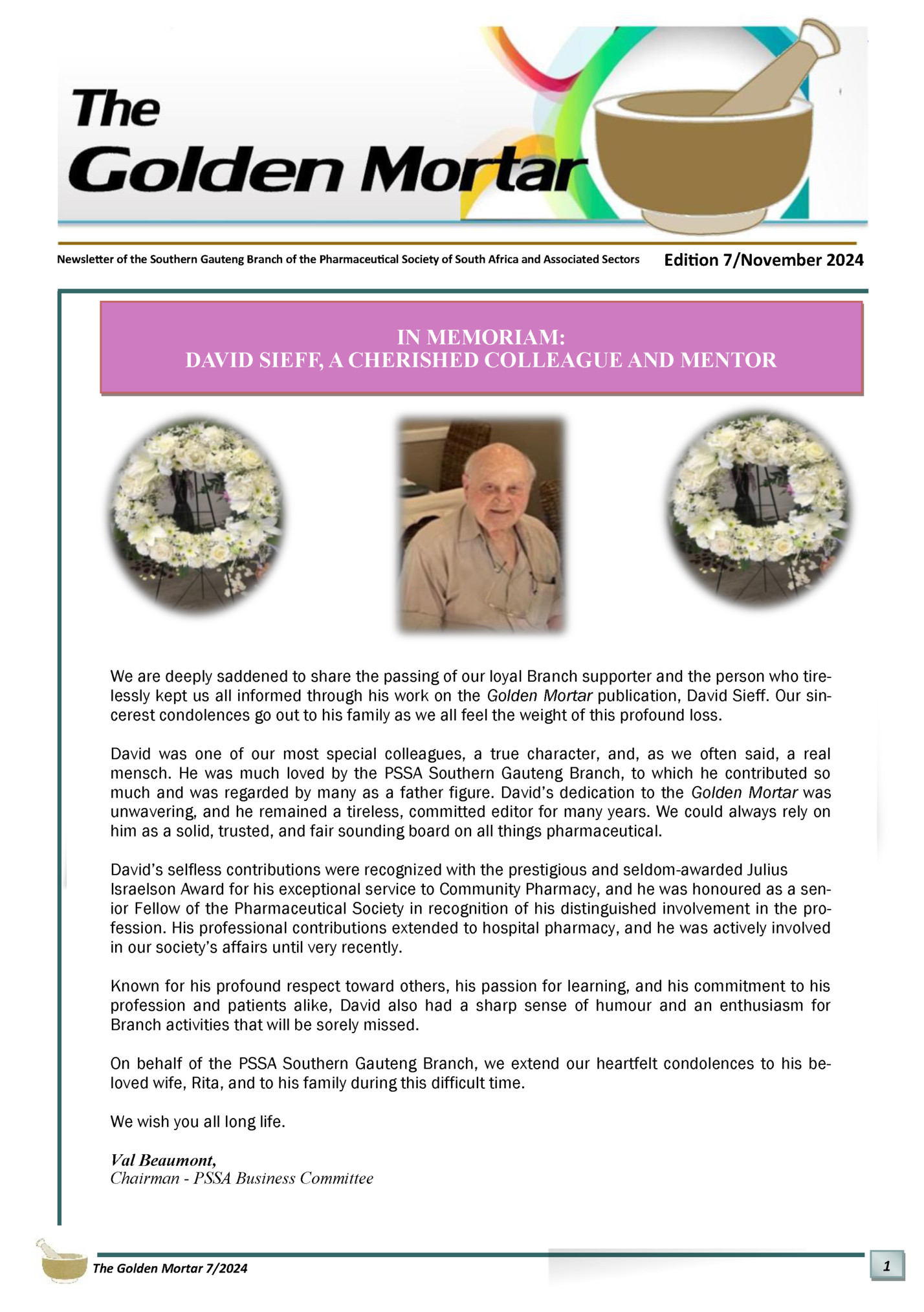
1. In Memory of Dave Sieff 3 The Opening of Melrose Surgical Centre, 52 Glenhove Road 9. PSSA Book Department 11 National Pharmacy Museum Artefacts 12. Professional Indemnity insurance 13 - 17 PSSA SG Symposium Recap 4-5 Marburg Virus Reports from SAACP & SAAPI 6-9 A reflection from a young pharmacist 10 - 11 Attending FIP Congress 2024 11 - 12 How does the Industry Pharmacist contribute to Healthcare Innovation? 18. SAAHIP SG Branch AGM Reminder Extended Deadline Date for Abstract Submission The Golden Mortar 7/2024 2
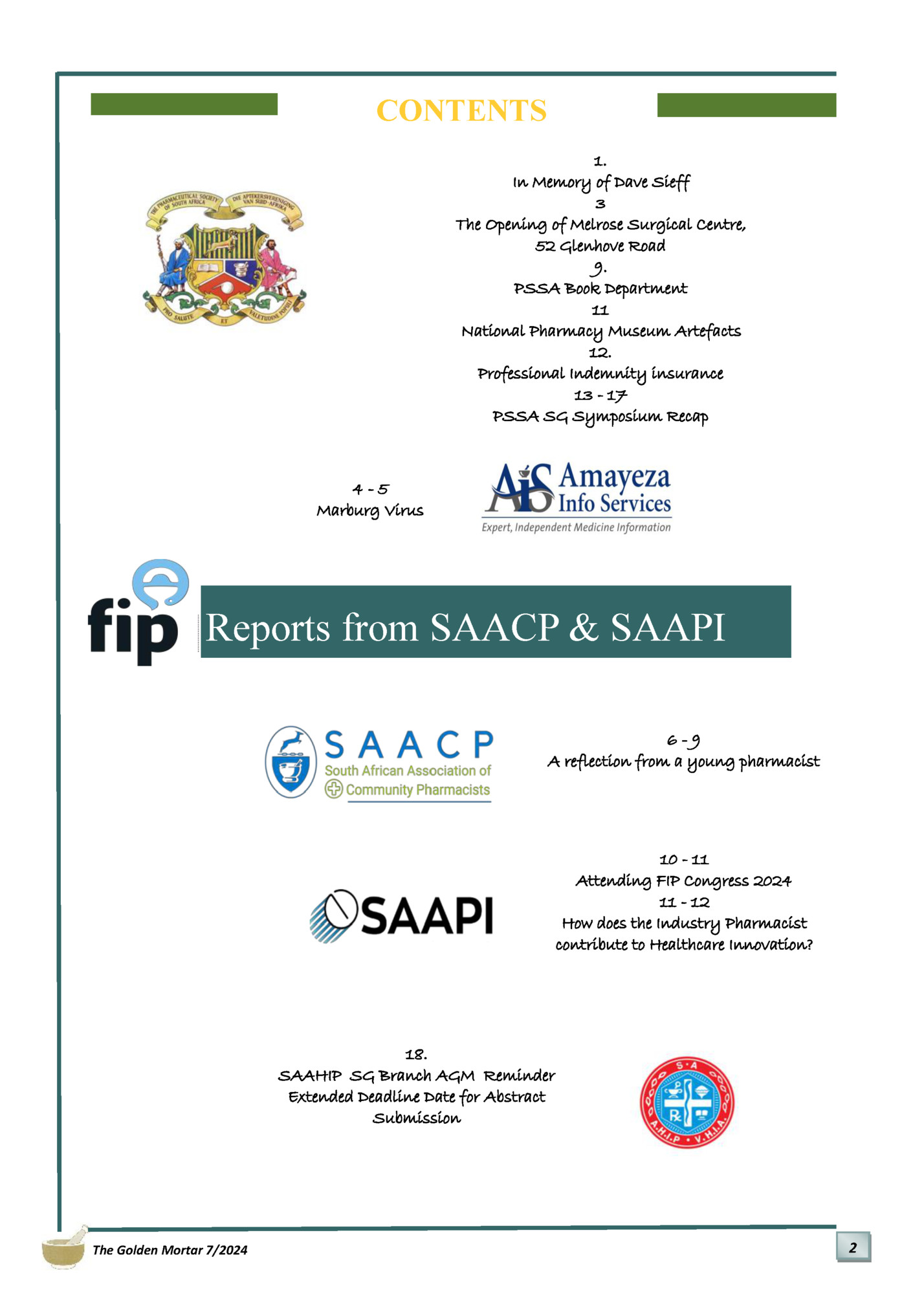
52 GLENHOVE ROAD by Val Beaumont I attended the opening of the Melrose Surgical Centre on Monday, 30 October 2024 in our old 52 Glenhove. In my wildest dreams I could not have imagined such a dramatic conversion. It is now a fabulous, ultra modern three story day hospital with operating theatre, dialysis unit, radiology and endoscopy services, a pharmacy, day wards, a coffee shop (run by Howie the caterer that worked for us) and they have kept and upgraded the auditorium which may be useful for us. Worth visiting if you knew the old building. The conversion has been done very cleverly. The Golden Mortar 7/2024 3
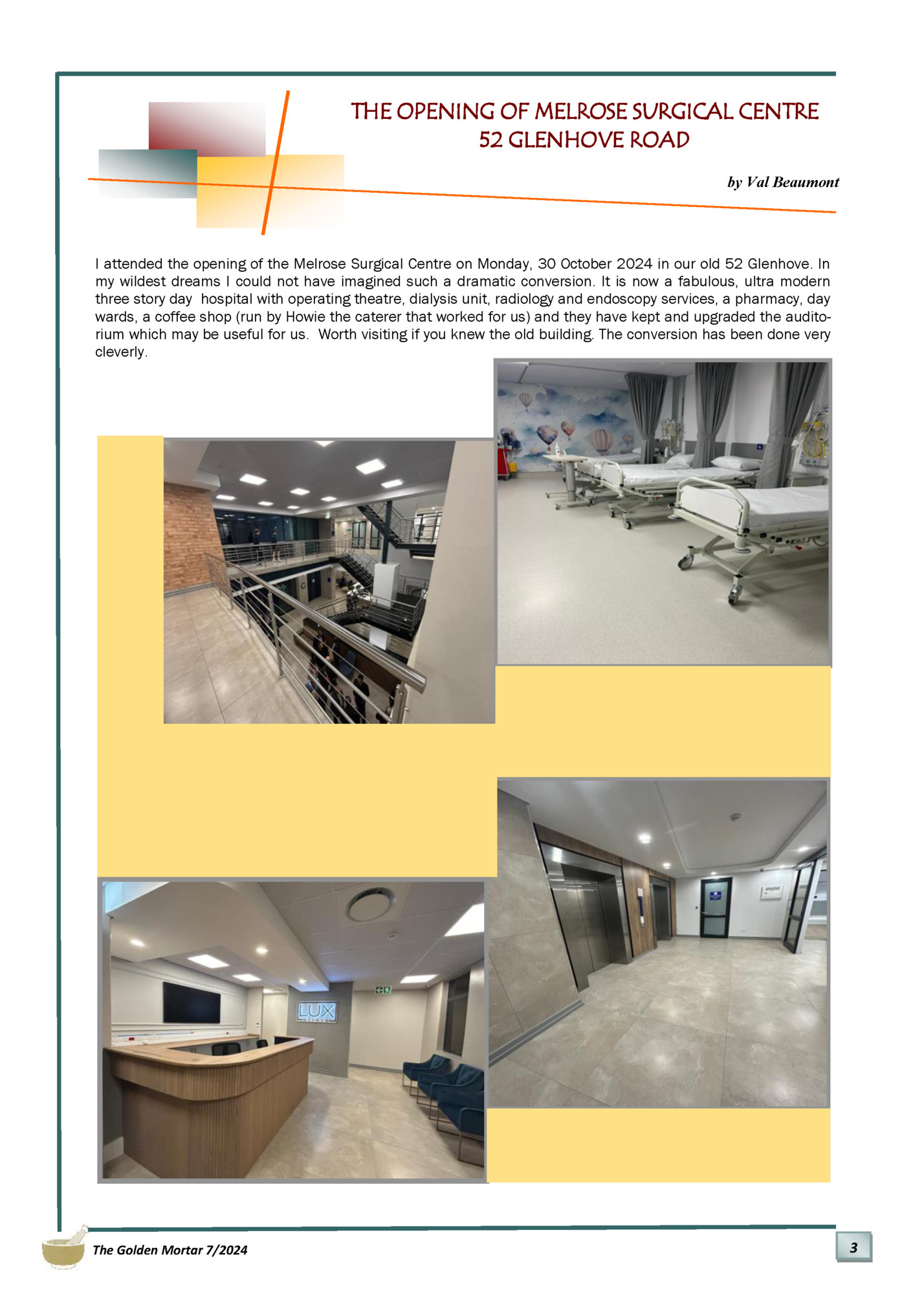
MARBURG VIRUS INTRODUCTION Marburg virus disease is caused by the Marburg Virus, a filovirus that is very similar to Ebola virus. The disease can cause fatigue, haemorrhaging, fever, nausea, vomiting, diarrhoea, dehydration and rash. On 27 September 2024, the Rwanda Ministry of Health announced an outbreak of Marburg virus and as of 17 October 2024 at least 62 confirmed cases and 15 deaths have been reported. Most of these cases occurred in healthcare workers. Marburg virus disease was first identified in 1967 during outbreaks in Marburg and Frankfurt in Germany, and in Belgrade, Serbia. The outbreaks were linked to laboratory workers exposed to infected African green monkeys imported from Uganda. The virus is zoonotic, meaning it is transmitted to humans from animal hosts. The primary natural host of Marburg virus is believed to be the Egyptian fruit bat (Rousettus aegyptiacus) which is often found in caves, mines and similar structures. TRANSMISSION AND SYMPTOMS Transmission of Marburg virus from animals to humans mostly occurs through prolonged exposure to mines or caves inhabited by fruit bat colonies. Human-to-human transmission can occur via direct contact with the blood, secretions, organs, or other bodily fluids of infected persons, or through surfaces and materials (e.g. bedding and clothing) contaminated with these fluids. After an incubation period ranging from 2 to 21 days, the disease starts abruptly with high fever, severe headache and severe malaise. On the third day, patients can present with severe watery diarrhoea, abdominal pain and cramping, nausea and vomiting. Other early symptoms may include conjunctivitis, arthritis, myalgia, fatigue, non-itchy maculopapular rash, dehydration and a dry throat. In severe cases, haemorrhagic manifestations (bleeding from needle puncture sites, mouth/gums, melaena and epistaxis) may appear between 5 and 7 days from onset of symptoms. Fatal cases usually have some form of bleeding and death occurs most often between eight and nine days after symptom onset, usually due to severe blood loss and shock. DIAGNOSIS AND TREATMENT Specific laboratory tests that can diagnose Marburg virus include serological testing for IgG and IgM antibodies, RT-PCR detection of the virus and virus isolation and are especially useful when a disease is still in its early stages. There is no approved vaccine or treatment available for Marburg virus disease. Treatment is supportive and aims to manage symptoms and maintain vital bodily functions. This includes hydration, pain management, blood transfusions, and treatment of secondary infections. There is currently no approved vaccine available for Marburg virus. A recombinant vaccine against Ebola virus disease includes a Marburg virus antigen and may potentially be used but has not been tested for efficacy against Marburg virus disease. …/ continued on page 5 The Golden Mortar 7/2024 4
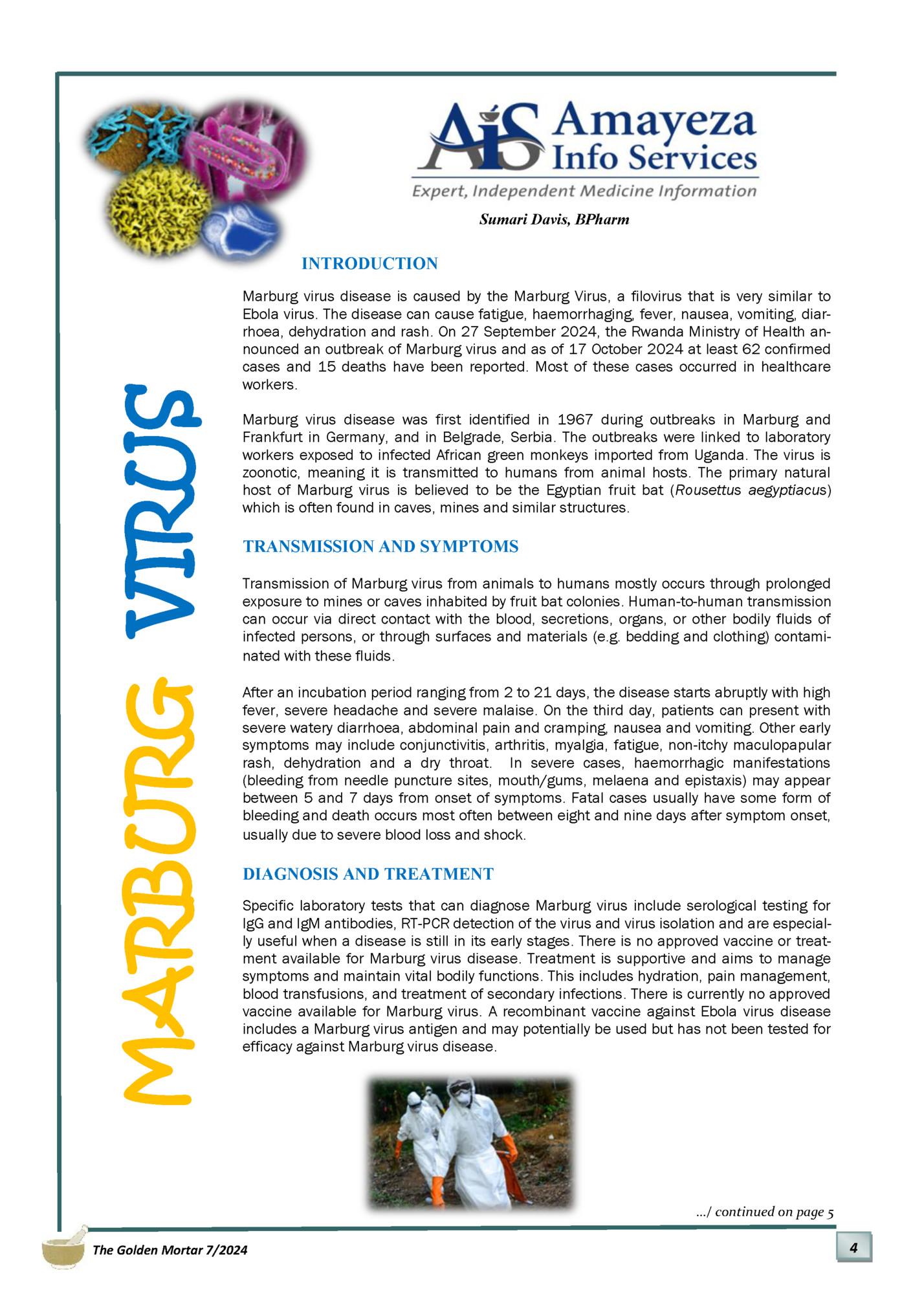
RISK AND RECOMMENDATIONS In 1975 in South Africa, a man with a travel history to Zimbabwe was hospitalised with Marburg virus disease. His travel companion and one healthcare worker also subsequently became infected. He passed away but the two other patients were vigorously treated symptomatically and survived. The World Health Organization assesses the risk of this outbreak as low at the global level. However, it is important to raise awareness and communicate the steps that can be taken to prevent infection, especially for people who will be travelling to affected areas. Since Marburg virus is spread through direct contact with blood and or bodily fluids of infected persons, it is recommended to avoid contact with infected persons. The following advice should be given to tourists: • • • Avoid contact with persons exhibiting symptoms of Marburg virus. This includes avoiding participation in rituals and funerals and burials of patients who died from Marburg virus disease Avoid visiting healthcare facilities in the affected areas for non-urgent medical care or for nonmedical reasons Avoid habitats that may be populated by bats such as caves or mines as well as close contact with wild animals (both alive and dead), including monkeys, forest antelopes, rodents, and bats in areas where Marburg virus is known to occur. This includes manipulation or consumption of any type of bushmeat. Travelers returning from Rwanda should also monitor for any symptoms of Marburg virus disease and seek prompt medical care if any of these symptoms develop. It is important that they provide the healthcare professional with information on their travel history as well as any possible exposure history and close contacts. REFERENCES 1. NICD Centre for Emerging Zoonotic and Parasitic diseases. Marburg Virus Disease Updated Sept 2024 Accessed 14 Oct 2024 Available from: https://www.nicd.ac.za/wp-content/uploads/2024/10/ MVDFAQS_2024.pdf 2. NICD Marburg virus key facts. Accessed 14 Oct 2024. Available from: https://www.nicd.ac.za/wp-content/ uploads/2024/10/MARBURG-VIRUS-KEY-FACTS.pdf 3. CDC Marburg virus disease. History of Marburg Outbreaks. Updated 2 May 2024, Accessed 14 Oct 2024. Available from: https://www.cdc.gov/marburg/outbreaks/index.html 4. European Centre for Disease Prevention and Control. Weekly Bulletin Communicable disease threats report. Week 41, 5-11 October 2024. Accessed 14 October 2024. Available from: https://www.ecdc.europa.eu/ sites/default/files/documents/Communicable-disease-threats-report-week-41-2024.pdf 5. World Health Organization. Marburg virus disease – Rwanda. Updated 30 September 2024; Accessed: 14 Oct. 2024. Available from: https://www.who.int/emergencies/disease-outbreak-news/item/2024-DON537 6. Cullinan K. Rwanda’s Marburg outbreak wanes but Mpox continues to spread. In Health Policy Watch. Updated 17 Oct 2024; Accessed 18 Oct 2024. Available from: https://healthpolicy-watch.news/rwandas-marburgoutbreak-wanes-but-mpox-continues-to-spread/ The Golden Mortar 7/2024 5
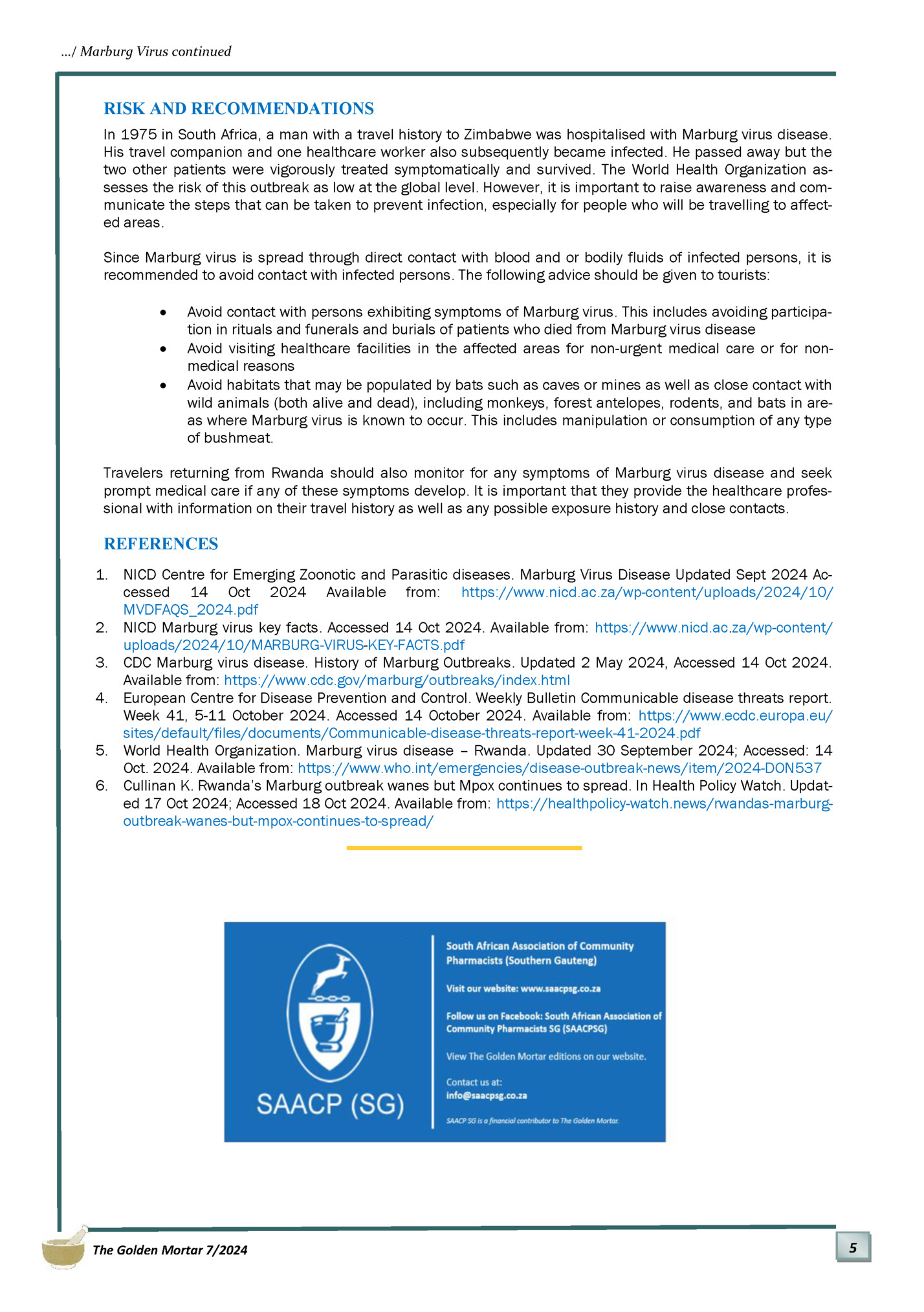
A reflection from a young pharmacist by Makoma Ramalepe INTRODUCTION I had the privilege to attend my first-ever international pharmacy conference, the 82nd World Congress of Pharmacy and Pharmaceutical Sciences which was held in Cape Town by the International Pharmaceutical Federation (FIP) from 1-4 September 2024. This was an incredible experience that brought together pharmacists from all over the world to hold discussions shaping the future of pharmacy in the beautiful city of Cape Town. The congress reinforced the evolving role of pharmacists and emphasized their critical contributions to shaping the future of healthcare, particularly in low- and middleincome countries like South Africa. With the theme of “Innovating for the Future of Healthcare”, the sessions focused on advancements in digital health, sustainability, patient-centric care, and innovations that can change pharmacy practice for the better. TRANSFORMATION TO EQUITABLE AND QUALITY HEALTHCARE Dr. Pakishe Aaron Motsoaledi, South Africa’s Minister of Health, delivered a captivating speech on South Africa’s journey toward equitable and quality healthcare. Makoma Ramalepe & Martin Nwofiah He emphasized the role of pharmacists in addressing public health challenges and disparities, especially within the anticipated National Health Insurance (NHI) system, highlighting the necessity for universal access to healthcare. His address touched on the importance of bridging the healthcare gap and ensuring that quality healthcare is not a privilege, but a right for all South Africans, especially in under-resourced areas. The transformation requires concerted efforts from all healthcare professionals as by working together we will be able to transform the health system and serve humanity. THE EVOLUTION ROLE OF THE PHARMACIST One of the focal sessions explored the continuously expanding role of pharmacists. In today’s healthcare environment, pharmacists are no longer simply traditional compounders of medicines, but they are at the forefront of patient care, directly involved in disease management, health promotion, and preventive care. As primary healthcare providers, they engage patients through e-health platforms, telemedicine, and pharmacogenomic interventions, contributing significantly to better healthcare outcomes. In a resource strained healthcare environment like sub-Saharan Africa, where respiratory diseases such as lower respiratory tract infections (LRTIs) remain the leading cause of morbidity, pharmacists have become trusted sources for managing these conditions. The role pharmacists play in administering point-of-care testing and managing diseases such as diabetes, respiratory infections, and malaria was also underlined as vital to strengthening public health systems. The session shifted my mindset, making me realize that the future of pharmacy is now, and I must fully equip myself for this evolving role to make a meaningful impact. PHARMACISTS IN HPV-RELATED DISEASES AND CANCER’S ELIMINATION This session shed light on the pivotal role pharmacists play in the elimination of HPV-related diseases, particularly cervical cancer. Pharmacists are uniquely positioned to educate patients on HPV vaccination and the importance of regular screening. The session discussed efforts to drive vaccination campaigns, ensuring broad public access to vaccines as part of cancer prevention initiatives. Such proactive measures such as vaccinating both girls and boys at early ages, supported by pharmacists, are essential in the global effort to eliminate HPVrelated cancers, especially in underserved communities. …/ continued on page 7 The Golden Mortar 7/2024 6
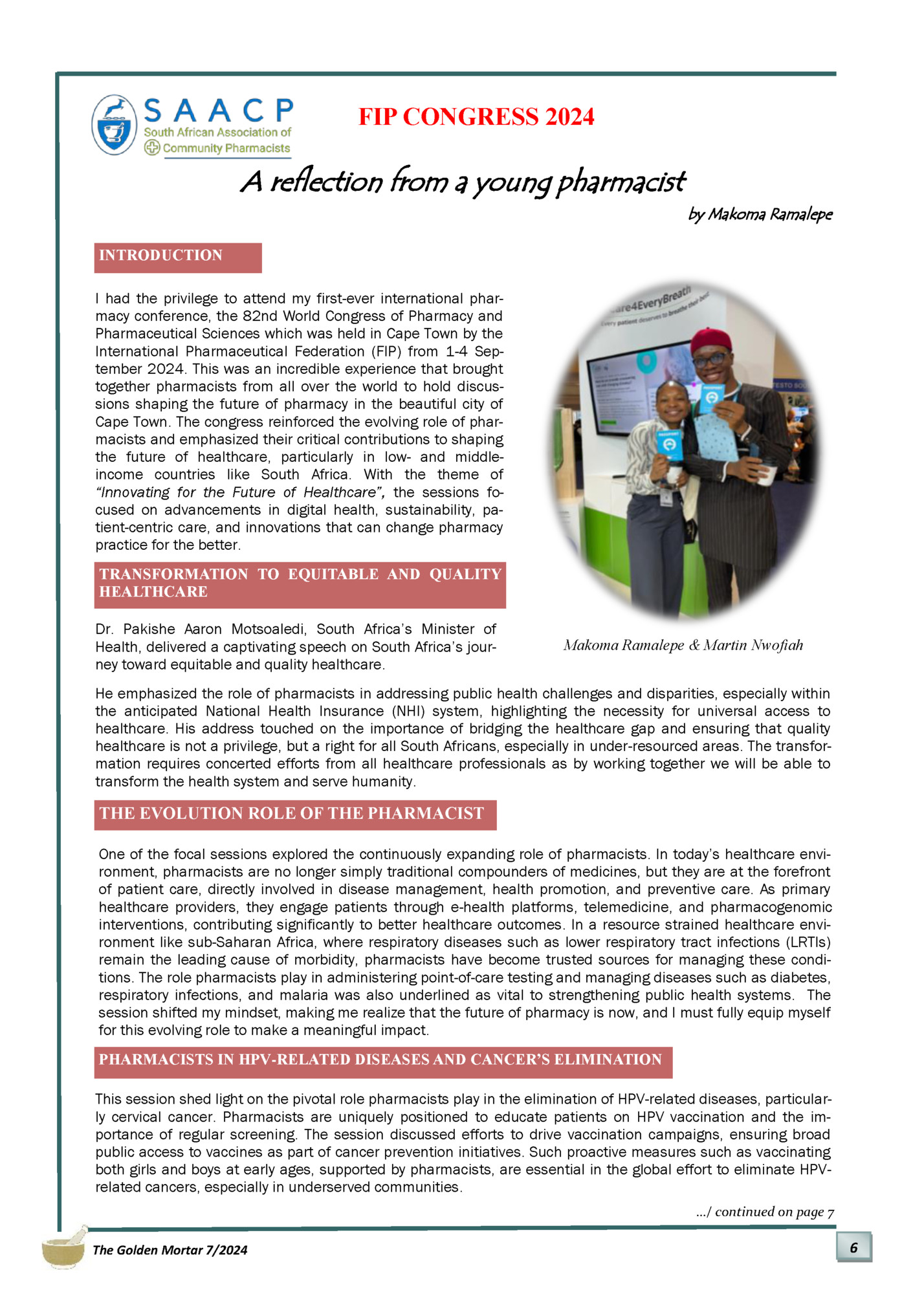
During a breakout session, I had the opportunity to meet a pharmacist heading an immunization-delivery project to deliver vaccines to those in need, in Africa. This project has the potential to support governments in enabling access to vaccines to save lives. Observing the amazing work colleagues are doing worldwide inspired me to do more, in my own area of practice as a young pharmacist. L - R: Makoma Ramalepe, Nasiphi Nkatshane, Mmatlou Rakgase, Esther Shuping, Mulanga Mathoho & Phiwo-Kuhle Maxambela ADVANCING OPPORTUNITIES FOR PATIENT-CENTRIC DRUG DELIVERY SYSTEM Innovations in patient-centric drug delivery systems were highlighted as a game-changer in the pharmaceutical industry. The session focused on innovating more efficient, accessible and user-friendly drug administration methods that cater to individual patient needs. This includes developing technology that makes treatments easier to manage at home, reducing the strain on healthcare facilities and improving patient adherence. This employs a holistic approach to patient care and their quality of life. Pharmacists are involved in implementing these new drug delivery systems, helping patients manage chronic conditions more effectively. For example, in special patient populations such as pediatrics, geriatrics and pregnant women, drug safety, efficacy and quality profile with minimal side effects is desirable to improve patient compliance and shorten treatment regimens for both communicable and non-communicable diseases. MICRONEEDLE TECHNOLOGY The session / discussion around microneedle technology showcased its potential to revolutionize drug delivery, offering a painless, minimally invasive alternative to traditional injections. Microneedle patches are very small hypodermic needles that provide transdermal delivery system for therapeutic drugs and vaccines. The ability for patients to administer medication at home without needing complex equipment is a breakthrough, particularly in resource-limited settings. This technology has the potential for improving adherence to treatment regimens and enhancing patient comfort, especially for long-term therapies. Its affordability also makes it a feasible option for healthcare systems looking to scale up treatment availability, they offer improved thermostability and easy storage and transport due to their miniature form. One of the key limitations highlighted was their inability to administer drugs over a large surface area, hence the STAR particles technology for topical delivery was implemented to address this gap. STAR particles, compared to traditional gel topical agents, perform better in enhancing treatments such as cancer, showing positive results in clinical trials. The use of microneedles for intracellular fluid targeting was another fascinating innovation discussed. By making tiny, painless punctures in the skin without causing bleeding, microneedles can deliver drugs to specific areas, such as the suprachoroidal space of the eye, offering more precise treatments with minimal side effects. This development has the potential to revolutionize how we treat eye diseases and other conditions that require localized delivery of therapeutics. …/ continued on page 8 The Golden Mortar 7/2024 7
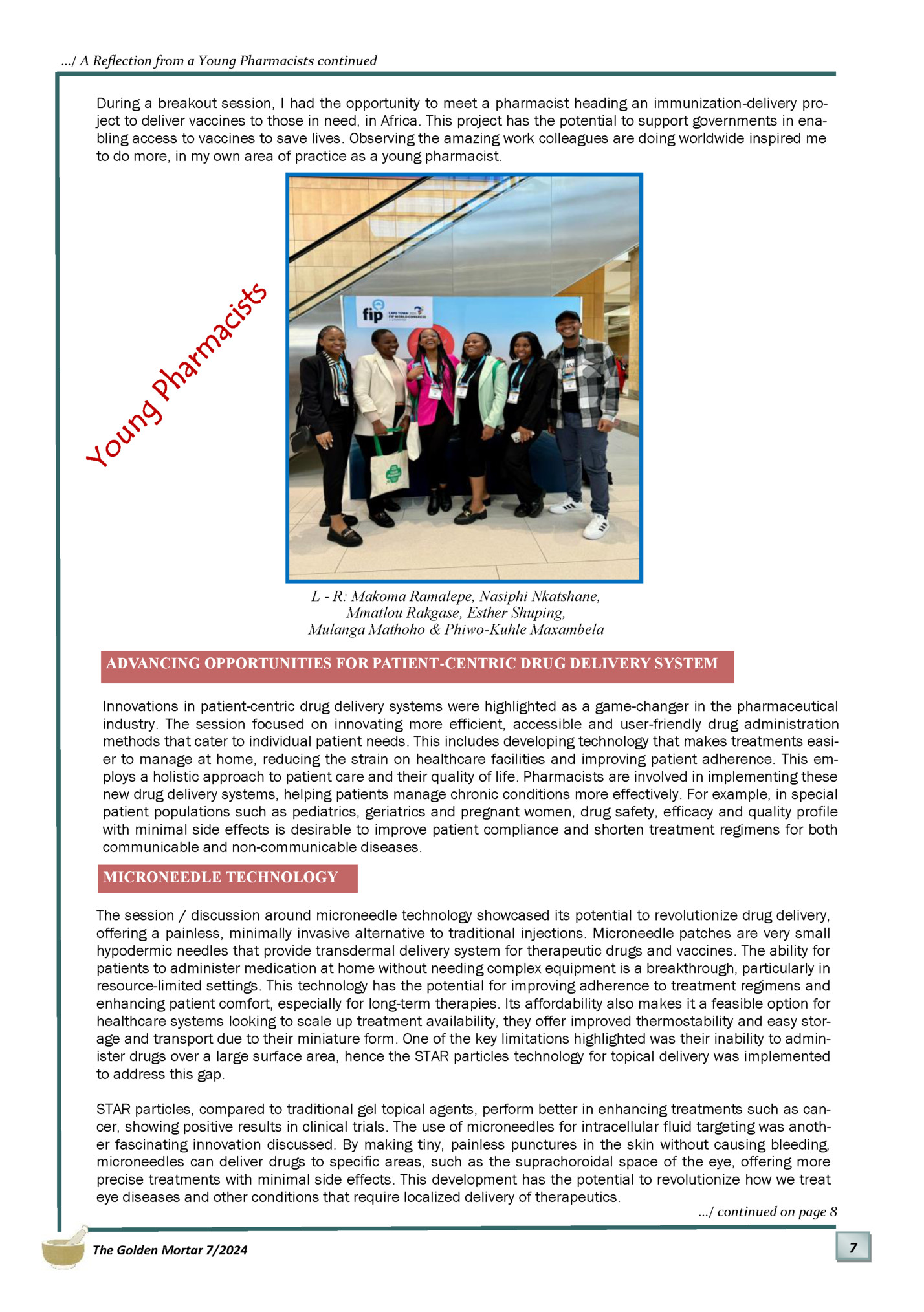
BOOSTING BRAIN COGNITIVE FUNCTION WITH MULTIVITAMINS Could a simple pharmacy purchase benefit brain health? This intriguing session was led by world memory champion Dominic O’Brien and Dr Howard Sesso. The presentation indicated tips to boost cognitive function and how to remember things by using association, imagination and location. It further highlighted that statistically, there are significant benefits of over the counter (OTC) multivitamins on cognitive brain function on both global cognition and episodic memory. The presentation highlighted the importance of pharmacists as key links between consumers and their decisions to support brain health. The effect of a daily multivitamin on global cognition over 2-3 years was shown to possibly reduce cognitive aging by 2 years compared to placebo. Pharmacists are at the forefront of advising patients on the adequate use of multivitamins, ensuring they choose products that are both safe and effective. This is relevant given the rising incidence of cognitive decline and mental health disorders globally, making brain health a critical area of focus. OVERVIEW OF ALL AI AND ITS RELEVANCE IN HEALTHCARE Digital health and artificial intelligence (AI) were major themes widely discussed at the congress, reflecting their growing importance in modern healthcare that pharmacists should not shy away from. AI is transforming healthcare by reducing administrative burden to free up capacity for value-added tasks and efficient data analysis — enabling more accurate diagnostics, personalized treatment plans, and improved medication management. This session on AI explored the shift from being product-centric as the traditional role to being patientcentric as the evolving role of the pharmacist and the AI applications in pharmacy, including tailored treatment plans, precision medicine, medicine error detection, adverse drug event prediction, early detection of diseases and continuous monitoring. Pharmacists are integrating AI tools to optimize patient care, making healthcare delivery more efficient and tailored to individual needs. The relevance of AI in the future of pharmacy cannot be overstated, as it empowers both healthcare professionals and patients in meeting their therapeutic goals. SUSTAINABILITY IN PHARMACY: A CALL TO ACTION This session placed significant emphasis on sustainability, calling on pharmacists to take active steps in reducing the environmental impact of pharmaceutical products. Consumer education on the appropriate medicine disposal methods as a mitigation action to supporting eco-friendly pharmaceutical practices was highlighted. Pharmacists are encouraged to lead initiatives that contribute to environmental conservation. The session called for a collective effort within the pharmacy profession to adopt more sustainable practices, ensuring that healthcare innovation aligns with the principles of environmental responsibility such as e-labeling and the development of biodegradable formulations and medicine packaging. Pharmacies were also encouraged to participate in take-back programs however, the medical waste costs incurred by the pharmacies remain a barrier. PHARMACOGENOMICS: INDIVIDUALIZED THERAPY AS THE FUTURE OF PHARMACY ‘If every person is different, why should your medication be the same?’ One of the most exciting developments in pharmacy is the growing role of pharmacogenetics and its potential to revolutionize patient care through individualized therapy. The use of pharmacogenomics enables healthcare providers to tailor treatments based on a patient’s genetic profile, which significantly improves drug efficacy, reduces adverse effects, and promotes better patient adherence. An important aspect of this approach is using (Polymerase chain reaction) PCR (polymerase chain reaction) techniques to lower the costs of genetic testing. Understanding drug behaviour at genetic level in the body, is crucial for optimizing therapeutic outcomes as pharmacists can make informed pharmaceutical decisions, ensuring that the therapy chosen will be both effective and safe for the patient. It was highlighted in the session that in pharmacogenomics, identifying how genes behave— the phenotype—is key to predicting drug response. If a drug doesn’t interact with a patient’s genetic makeup as intended, the result can be reduced efficacy or unwanted side effects. Therefore, by leveraging pharmacogenetics insights, we can optimize therapeutic outcomes. However, barriers remain in fully implementing personalized medicine. One of the significant challenges is the limited scope of pharmacists, which restricts their ability to fully integrate pharmacogenomics into everyday practice. Additionally, drug responses are not solely dependent on liver metabolism. Pharmacodynamics and pharmacokinetics, particularly in how drugs cross the blood-brain barrier, are critical considerations. This highlights that drug efficacy is also reliant on receptor behaviour in the body, not just metabolic processes. …/ continued on page 9 The Golden Mortar 7/2024 8
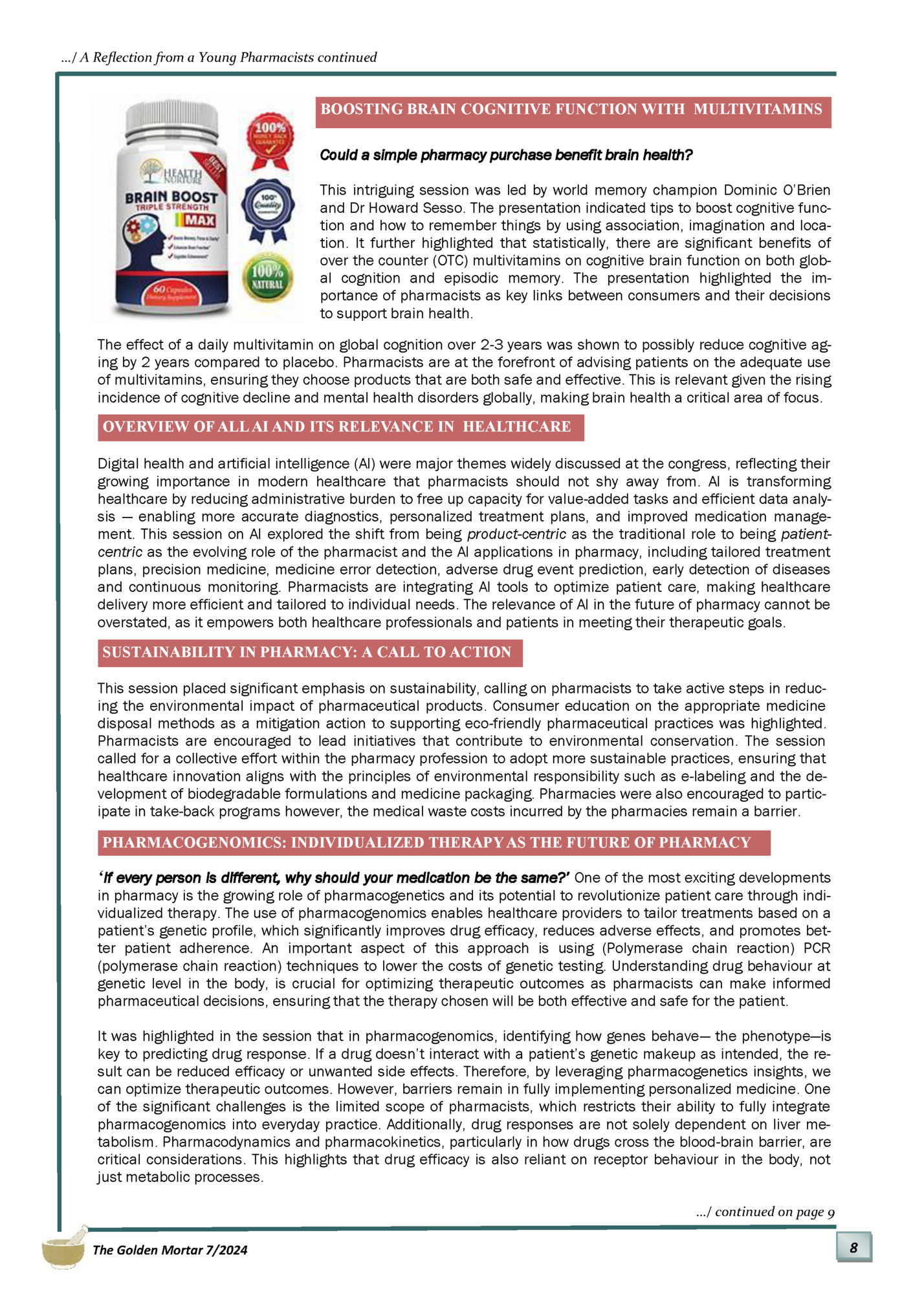
The development of this field is further hindered by under developed biopharmaceutical sectors and overburdened healthcare systems, especially n low and middle income countries. As the field continues to advance, pharmacists will play a pivotal role in its implementation, ensuring that therapies are tailored to the individual needs of patients for optimal health outcomes. EARLY DETECTION AND MONITORING OF CHRONIC CONDITIONS Practical tools for supporting the role of the pharmacist in the prevention and management of long-term diseases were made accessible, allowing pharmacists to explore the use of toolkits and screening tools that enable early detection and continuous monitoring of chronic conditions of their patients. Pharmacists are increasingly equipped with accessible tools that help identify and monitor diseases like hypertension, diabetes, and cardiovascular conditions at early stages. These innovations empower pharmacists to intervene earlier, providing patients with timely advice and referrals to prevent disease progression. This patient-centered approach is critical in improving overall health outcomes and alleviates the burden on health care system (HCS). An immediate kidney function screening test by Nova Biomedical was showcased and could test for Creatinine and EGFR in 30 seconds from a capillary Finger stick Sample, this development will make a significant impact in the early identification and monitoring of chronic kidney disease (CKD) and Acute Kidney Injury (AKI) in community settings and reduce healthcare resource utilization. CONCLUSION Attending the Congress was an immensely enriching experience in my career, that broadened my perspective on the future of pharmacy and healthcare. It was exciting to meet colleagues from different spheres of pharmacy, exchange ideas and make connections. It was reassuring to observe that our South African standards of pharmacy practice are aligned with global practices as our scope is broad and our role is more patient centered. From the evolving role of pharmacists in managing chronic diseases and promoting public health, to the advanced innovations in drug delivery and AI-driven healthcare tools, this congress offered a glimpse into the future of pharmacy practice. I am empowered and motivated by the amazing work that pharmacists are doing globally with the patient being the point of focus. As the pharmacy profession continues to evolve, it is clear that continuous learning, innovation, and collaboration will remain the cornerstone of pharmaceutical health. ‘Think Health, Think Pharmacy!’ ACKNOWLEDGEMENT: (Special thanks for making my attendance at this remarkable event possible) 1. SAACP Southern Gauteng Branch 2. PSSA Young Pharmacists Group 3. PSSA “it is clear that continuous learning, innovation, and collaboration will remain the cornerstone of pharmaceutical health” THE PSSA BOOK DEPARTMENT Do you know that the Book Department has a range of essential publications for pharmacists at preferential prices for members of the PSSA? From overseas publications such as Martindale, Merck Manual and Dorland’s Illustrated Medical Dictionary to local publications such as the South African Medicines Formulary (SAMF) and the Scheduled Substance Register. Ordering is this simple: Go to the PSSA website, www.pssa.org.za, click on the Hello, sign in button to order books at the discounted fee for members. Choose Book Store and complete online. Or Contact Dinette at PSSA National Office on (012) 470-9559 or at dinette@pssa.org.za The Golden Mortar 7/2024 9

Fleepit Digital © 2021